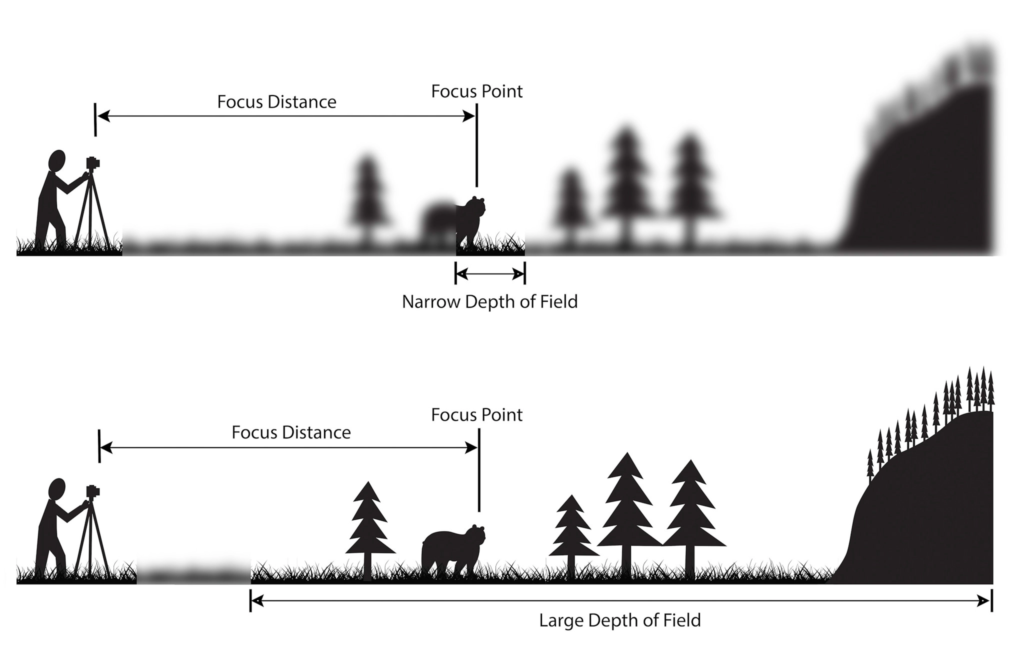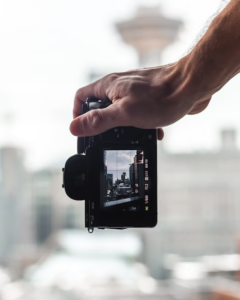What is Depth of Field?
Depth of field is one of the essential concepts in photography. The depth of field in a photo refers to the distance between the closest and farthest objects that appears acceptably sharp. Depth of field differs based on camera type, aperture, and focusing distance. In addition, the viewing distance and print size can contribute to the perception of depth of field.

The depth of field does not change from sharp to unsharp abruptly. Instead, there is a gradual transition. Everything in front of or in the back of the focusing distance starts to lose sharpness. Our eyes or the resolution of the camera do not perceive this. This is based on a scientific phenomenon called the circle of confusion.
Circle of Confusion
As there is no critical transition point, the term circle of confusion is used to establish how much a point should be blurred to be regarded as unsharp. Suppose the circle of confusion is perceivable by our eyes. In that case, the region is outside the depth of field, and it is not acceptably sharp.
When can our eyes perceive the circle of confusion?
A circle of confusion that is acceptably sharp would go unnoticed when enlarged to a standard 8×10-inch print and seen from a viewing distance of about 1 foot. Camera manufacturers assume a circle of confusion at this viewing distance, and the print size is insignificant if it is no larger than 0.01 inches when enlarged. When providing lens depth of field markers, camera manufacturers use the 0.01-inch standard. An individual with 20/20 vision or better can recognize features 1/3 this size. So, the circle of confusion should be smaller than this to reach acceptable sharpness.

For each viewing distance and print size combination, a different maximum circle of confusion is applicable. Depth of field only sets a maximum value for the circle of confusion and does not describe bokeh once they become out of focus. Therefore, two images with similar depth of field can have different bokeh, depending on the lens diaphragm’s shape.
The out-of-focus or “blurry” regions of a picture created by a camera lens are known as bokeh. The blur separating the image from the background in photography results from a shallow depth of focus and is sometimes referred to as “background blur.” It is usually circular as it scatters light within the circular element of the eye or the camera lens called the diaphragm or iris. As the iris widens, the circles enlarge in the blurry background. The circle of confusion is not an actual circle, but when it is minimal, it is approximated. Most lenses will present it as a polygonal shape with 5-8 sides when it becomes significant.
Why is Depth of Field important?
Depth of Field can influence your image and change the meaning and intention. For example, you can selectively isolate a subject from its background by having a narrow Depth of Field. You can also have everything from the foreground to infinity in focus, ensuring you have a sharp image.
Usage of Depth of Field
Depth of field refers to the part of a photograph that is sharp and appropriate. The amount of clarity and focus varies based on the settings you choose and the camera and lens you use. The depth of field indicates the proportion of the distance or depth that is “in focus”. Implementing this, a clear and detailed image can be seen. Three criteria are used to determine the depth of field: the size of the aperture, how distant the lens is from the object, and the lens’s focal length.

To use the depth of field, change the aperture setting on your camera to control the depth of field. A camera lens, like your eye, has an iris that can open and shut to allow in more or less light. The size of this slot, or aperture, is controlled by altering the aperture setting, which is measured in f-stops. For example, if you have a bigger aperture, your depth will be shallower. Conversely, your depth of field will go larger as the aperture gets lower. Thus more of your picture will be sharp.
Depth of field is mainly concerned with the lens’s aperture used for photography, while camera distance is also vital. The distance between your camera and the subject where your focus point is located has a significant effect. The lower the depth of field, the closer you are to your subject. As a result, the more distant from the subject, the greater the depth of field.
- Adjust Your Camera’s Aperture Settings by choosing an f-stop of f/2.8 results in a shallow depth of field, while choosing an f/11 results in a deep depth of field.
- Altering the Distance Between Camera and the Subject Using fast prime lenses generates beautiful bokeh or out-of-focus features in the backdrop.
- Use Focal Length A 14-24 mm lens for a wide-angle lens.
- A 35-70 mm lens camera that comes with many DSLR cameras.
- Telephoto lenses have a high magnification and are available in focal lengths ranging from 70mm to 300mm.
- A narrow depth of field will separate the subject from the background in portraits.
- You can use a narrow depth of field to declutter an image’s background and focus on the foreground.
- Portrait photography uses a shallow depth of field to draw focus on the subject.
- A wide Depth of Field in landscape photographs will include everything in focus.
- When shooting through a frame, you can use a wide depth of field to ensure that the subject and the frame are in focus.
- Landscape photography utilizes a wide depth of field to capture even the most minute details in the landscape.
Composing shots in layers
This approach is called layering and uses the foreground, the subject, and the backdrop to portray a complete picture by integrating them. This is achieved by compressing or segregating the elements by altering the focal length of your camera. Depth of field, shutter speed, and lighting are all used to enhance the visual complexity of your photos.

Out-of-focus elements
When an element is probably losing focus, the focus-out event happens. The primary distinction between this action and blur is that this method produces focus-out bubbles.

Get down low
With a low-angle view, the traditional eye-level perspective of photography is modified. Instead of photographing at normal height, a low-angle shot happens when the camera is angled downward and below the subject’s eye line. As a result, low-angle photography produces the illusion of a larger, taller, broader, and sometimes closer subject.

Atmospheric effects
The effect of atmospheric perspective is by adding an impact in two-dimensional photographs and creating the illusion of perspective, enhancing the image’s attractiveness. Ambiance and mood are critical components of photography. The mood establishes the emotional tone, while the environment establishes a feeling of place and time. Both of these characteristics engage the viewer, enabling them to form an emotional connection with the photograph.

Factors that Affect Depth of Field
- Aperture
- Subject & Camera Distance
- Focal Length
Factors affecting Depth of Field
Controlling Depth Of Field
Aperture and focusing distance determine the size of the circle of confusion on your camera’s sensor. Large apertures and closer focusing distances will result in a shallower depth of field.
Aperture
The aperture in photography is the opening of a photographic lens’ diaphragm, through which light passes to enter the camera. Aperture changes the quantity of light that passes through a camera lens when one expands or shrinks the aperture. The operation of an aperture is similar to that of human eyes. As our eyes move between dark and bright environments, the iris either expands or shrinks by controlling the size of our pupils. Similarly, you can change the aperture size depending on the light needed to reach the camera sensor.

Large Aperture = Shallow Depth of Field

Small Aperture = Deep Depth of Field

Subject & Camera Distance
The subject and the camera distance are also essential factors affecting the depth of field. If the distance is shorter, the depth of field will be shorter. The depth of field is shallow when you are closer to the subject. This is why even with a small aperture, you cannot get an entire subject in focus when you try to take a close-up shot.
Depth of Field and Distance to Subject
Focal Length
Wide-angle lenses with short focal lengths have a deeper depth of field than telephoto lenses with long focal lengths if the camera and subject distance are unchanged. However, suppose the camera and subject distance are adjusted to have the same magnification as the subject. In that case, the focal length will not influence the depth of field. Thus, though telephoto lenses seem to produce a shallower depth of field, they are used to magnify the subject when the photographer can’t get closer.
Suppose the subject holds the same fraction of the image for a telephoto and a wide-angle lens both the depth of field and focal length are similar. However, you need to get closer with a wide-angle lens or move farther with a telephoto lens.
| Focal Length (mm) | Focus Distance (m) | Depth of Field (m) |
| 10 | 0.5 | 0.482 |
| 20 | 1.0 | 0.421 |
| 50 | 2.5 | 0.406 |
| 100 | 5.0 | 0.404 |
| 200 | 10 | 0.404 |
| 400 | 20 | 0.404 |
Though the depth of field is constant, the fraction of the depth of field in front of and behind the focus distance changes with focal length.
| Focal Length (mm) | Distribution of the Depth of Field | |
| Rear | Front | |
| 10 | 70.2% | 29.8% |
| 20 | 60.1% | 39.9% |
| 50 | 54.0% | 46.0% |
| 100 | 52.0% | 48.0% |
| 200 | 51.0% | 49.0% |
| 400 | 50.5% | 49.5% |
If the focal length is longer, the depth of field might appear shallow as they enlarge the background relative to the foreground, making an out-of-focus background look further out of focus. This is because the blur has enlarged. However, the depth of field defines the sharp region of a photo and not the blurred sections. If you focus on a subject at the same distance by standing in the same place, a longer focal length lens will yield a shallower depth of field. This is because SLR cameras need a longer focal length to produce the same field of view. So, the depth of field is shallower for SLR cameras compared to compact digital cameras.
focal length and Depth of Field
Hyperfocal
The hyperfocal is a unique point of focus in the photograph for a given aperture and focal length that allows for maximizing the depth of field.
When you are focusing at the hyperfocal distance, the depth of field extends from half the point of focus to infinity. This is helpful to keep the whole image sharp. Next, you need to select the aperture and the point of focus at the hyperfocal distance. To calculate the hyperfocal distance, you can use a hyperfocal distance calculator such as PhotoPills. Here you can enter your focal length and aperture before planning a hyperfocal distance.
Hyperfocal distance and depth of field tricks
Sensor Size
Sensor size affects the depth of field, and cameras with smaller sensors have larger depths of field. You should be careful about the comparison. First, you need to look at camera lenses with the same effective focal length to get the same fields of view. Then, when you shoot with the same apertures at the same camera-subject distance, the larger sensors have a shallower Depth of Field. So, many professional portrait photographers prefer full-frame cameras.
| Camera | Crop Factor | Physical Focal Length (mm) | Effective Focal Length (mm) | Aperture | Depth of Field (m) |
| Full Frame | 10 | 120 | 120 | f/9 | 0.92 |
| APS-C | 1.5 | 80 | 120 | f/9 | 1.42 |
| Micro 4/3 | 2.0 | 60 | 120 | f/9 | 1.91 |
You can capture similar images using different sensor sizes cameras with the same depth of field. However, you need to divide the apertures by the crop factor to get the same depth of field.
Sensor size and depth of field
Calculating Depth of Field
For the depth of field calculation, you need to decide on an appropriate value for the maximum allowable circle of confusion. This is based on the camera type and the viewing distance or print size combination. Many DSLRs include a depth-of-field preview button. When you press this button, looking through the viewfinder, you get a look at how the actual image will be. However, the viewfinder will get very dark at small apertures, so it might be hard to get a preview.
On some camera models, you can use Live View to preview the depth of field. Mirrorless shooters have an advantage over DSLR shooters, as they can see on the digital viewfinder or the LCD. You can use the depth of field calculator tool to find the depth of field for your specific situation.
Conclusion
Do not stress too much about the depth of field in a picture. However, it is crucial to know when you need a small or large depth of field and how to create it. To get a shallower depth of field, either move closer to your subject or use the aperture. For a larger depth of field, move away from your subject or close the aperture. Try a longer focal length to achieve a shallower depth of field.
To increase the depth of field for sharpness,
- Use smaller aperture
- Use a short focal length lens
- Move further from the subject
To decrease the depth of field for blur,
- Use larger aperture
- Use a long focal-length lens
- Move close to the subject
Experiment with your camera and practice a lot to get to know it better.














